机械工程材料双语课件第二章
- 格式:ppt
- 大小:721.50 KB
- 文档页数:37
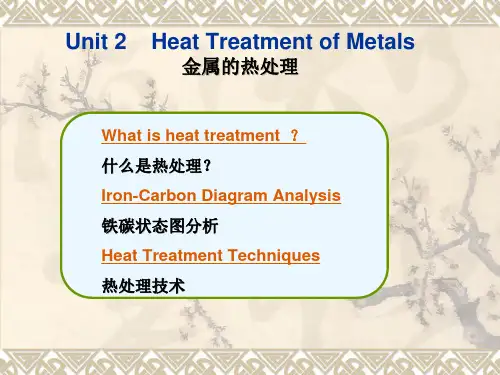
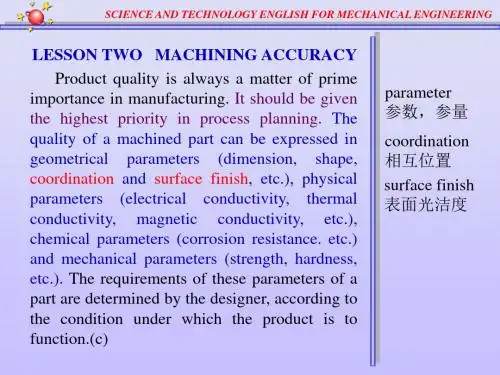

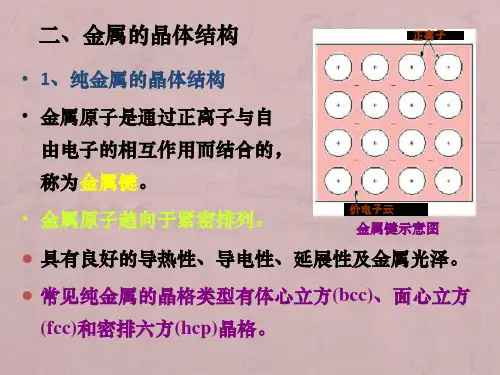
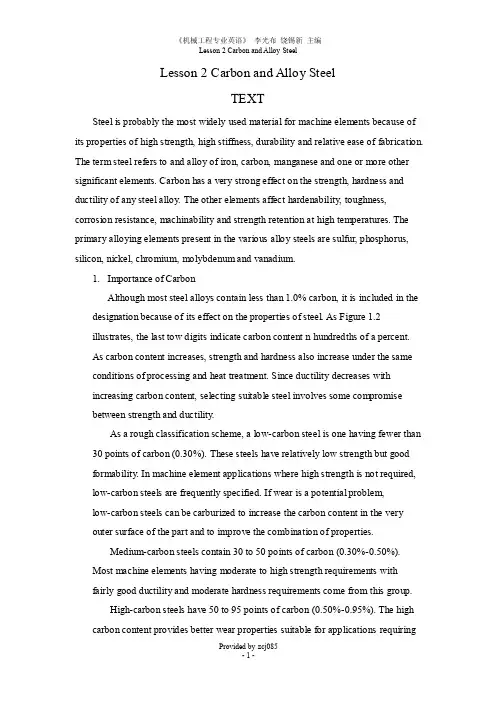
Lesson 2 Carbon and Alloy SteelTEXTSteel is probably the most widely used material for machine elements because of its properties of high strength, high stiffness, durability and relative ease of fabrication. The term steel refers to and alloy of iron, carbon, manganese and one or more other significant elements. Carbon has a very strong effect on the strength, hardness and ductility of any steel alloy. The other elements affect hardenability, toughness, corrosion resistance, machinability and strength retention at high temperatures. The primary alloying elements present in the various alloy steels are sulfur, phosphorus, silicon, nickel, chromium, molybdenum and vanadium.1.Importance of CarbonAlthough most steel alloys contain less than 1.0% carbon, it is included in the designation because of its effect on the properties of steel. As Figure 1.2illustrates, the last tow digits indicate carbon content n hundredths of a percent.As carbon content increases, strength and hardness also increase under the same conditions of processing and heat treatment. Since ductility decreases withincreasing carbon content, selecting suitable steel involves some compromisebetween strength and ductility.As a rough classification scheme, a low-carbon steel is one having fewer than30 points of carbon (0.30%). These steels have relatively low strength but goodformability. In machine element applications where high strength is not required, low-carbon steels are frequently specified. If wear is a potential problem,low-carbon steels can be carburized to increase the carbon content in the veryouter surface of the part and to improve the combination of properties.Medium-carbon steels contain 30 to 50 points of carbon (0.30%-0.50%).Most machine elements having moderate to high strength requirements withfairly good ductility and moderate hardness requirements come from this group.High-carbon steels have 50 to 95 points of carbon (0.50%-0.95%). The high carbon content provides better wear properties suitable for applications requiringdurable cutting edges and for applications where surfaces are subjected to constant abrasion. Tools, knives, chisels, and many agricultural implement components are among these uses.2.Stainless SteelsThe term stainless steel characterizes the high level of corrosion resistance. To be classified as a stainless steel, the alloy must have a chromium content of at least 10%. Most have 12% to 18% chromium.The three main groups of stainless steels are austenitic, ferritic, and martensitic. Austenitic stainless steels fall into the AISI 200 and 300 series. They are general-purpose grades with moderate strength. Most are not heat-treatable, and their final properties are determined by the amount of working. These alloys are nonmagnetic and are typically used in food processing equipment.Ferritic stainless steels belong to the AISI 400 series, designated as 405, 409, 430, 446, and so on. They are magnetic and perform well at elevated temperatures, from 1300℉to 1900℉(700℃-1040℃). They are notheat-treatable, but they can be cold-worked to improve properties. Typical applications include heat exchanger tubing, petroleum refining equipment, automotive trim, furnace parts, and chemical equipment.Martensitic stainless steels are also members of the AISI 400 series, including 403, 410, 414, 416, 420, 431 and 440 types. They are magnetic, can be heat-treated, and have higher strength than the AISI 200 and 300 series, while retaining good toughness. Typical uses include turbine engine parts, cutlery, scissors, pump parts, valve parts, surgical instruments, aircraft fittings, and marine hardware.3.Structural SteelsMost structural steels are designated by ASTM numbers established by American Society for Testing and Materials. The most common grade is ASTMA36, which has a minimum yield point of 36000 psi (248MPa) and is very ductile. It is basically a low-carbon, hot-rolled steel available in sheet, plate, bar, and structural shapes, such as wide-flange beams, American standard beams, channelsand angles.Most wide-flange beams are currently made using ASTM A992 structural steel, which has a yield point of 50 ksi to 65 ksi and a minimum tensile strength of 65 ksi. An additional requirement is that the maximum ratio of the yield point to the tensile strength is 0.85. This is a highly ductile steel, having a minimum of 21% elongation in a 2.00-inch gage length. Using this steel instead of the lower strength ASTM A36 steel typically allows smaller, lighter structural members at little or no additional cost.Hollow structural sections (HSS) are typically made from ASTM A500 steel that is cold-formed and either welded or made seamless. Included are round tubes and square rectangular shapes. There are different strength grades can bespecified. Some of these HSS products are made from ASTM A501 hot-formed steel having properties similar to the ASTM A36 hot-rolled steel.Many higher-strength grades of structural steel are available for use in construction, vehicular, and machine applications. They provide yield points in the range from 42 000 psi to 10 000 psi (290 MPa-700MPa).4.Tool SteelsTool steels refers to a group of steels typically used for cutting tools, punches, dies, shearing blades, chisels and similar uses. The numerous varieties of toolsteel materials have been classified into seven general types. Whereas most uses of tool steels are related to the field of manufacturing engineering, they are also pertinent to machine design where the ability to maintain a keen edge underabrasive conditions is required. Also, some tool steels have rather high shockresistance which may be desirable in machine components such as parts formechanical clutches, pawls, blades, guides for moving materials and clamps.READING MATERIALThe final properties of steels are dramatically affected by the way the steels are produced. Some processes involve mechanical working, such as rolling toa particular shape or drawing through the dies. In machine design, many bar-shaped parts, shafts, wire and structural members are produced in these ways. But most machine parts, particularly those carrying heavy loads, are heat-treated to produce high strength with acceptable toughness and ductility.Carbon steel bar and sheet forms are usually delivered in the as-rolling condition, that is, they are rolled at an elevated temperature that eases the rolling process. The rolling can also be done cold to improve strength and surface finish. Cold-drawn bar and wire have the highest strength of the forms, along with a very good surface finish. However, when a material is designated to be as-rolled, it should be assumed that it was hot-rolled.1.Heat TreatingHeat treating is the process in which steel is modified its properties by different elevated temperatures. Of the several processes available, those most used for machine steels are annealing, normalizing, through-hardening (quench and temper), and case hardening.Figure 1.3 shows the temperature-time cycles for these heat treating processes. The symbol RT indicates normal room temperature, and LC refers to the lower critical temperature at which the ferrite transformation begins during the heating of the steel. At the upper critical temperature (UC), the transformation is complete. These temperatures vary with the composition of the steel. For most medium-carbon (0.30%—0.50%) steels. UC is approximately 1 500°F(822℃). References giving detailed heat treating process data should be consulted.1)AnnealingFull annealing (Figure 1.3(a)) is performed by heating the steel above the upper critical temperature and holding it until the composition is uniform. Then the steel is cooled very slowly in the furnace until its temperature is below the lower critical temperature. Slow cooling to room temperature outside the furnace completes the process. This treatment produces a soft, low-strength form of the material, free of significant internal stresses. Parts are frequentlycold-formed or machined in the annealed condition.Stress relief annealing (Figure 1.3 (b)) is often used following welding, machining, or cold forming to relieve residual stresses and thereby minimize subsequent distortion. The steel is heated to approximately 1 000 °F to 1 200 °℉(540℃—650℃), held to achieve uniformity, and then slowly cooled in still air to room temperature.NormalizingNormalizing (Figure 1.3 (c)) is similar to annealing, but at a higher temperature, above the transformation range where austenite is formed, approximately 1 600 ℉(870℃). The result is a uniform internal structure in the steel and somewhat higher strength than annealing produces. Machinability and toughness are usually improved over the as-rolled condition.2.Through-Hardening and Quenching and TemperingThrough-hardening (Figure 1.3(d)) is accomplished by heating the steel to above the transformation range where austenite forms and then rapidly cooling it in a quenching medium. The rapid cooling causes the formation of martensite, the hard and strong form of steel. The properties of the martensite forms depend on the alloy’s composition. An alloy containing a minim um of 80% of its structure in the martensite form over the entire cross section has high hardenability. This is an important property to look for when selecting a requiring high strength and hardness steel. The common quenching media are water, brine, and special mineral oils. The selection of a quenching medium depends on the required cooling rate. Most machine steels use either oil or water quenching.Tempering is usually performed immediately after quenching and involves reheating the steel from a temperature of 400℉to 1 300℉(200℃—700℃) and then slowly cooling it in air to room temperature. This process modifies the steel’s properties. Tensile strength and yield strength decrease with increasing tempering temperature, whereas ductility improves, as indicated by an increase in the percent elongation. Thus, the designer can tailor the propertiesof the steel to meet specific requirements. Furthermore, the steel in its as-quenched condition has high internal stresses and is usually quite brittle. Machine parts should normally be tempered at 700 ℉(370℃) or higher after quenching.(a)full annealing (b) stress relief annealing(c) normalizing (d) quenching and tempering(through-hardening)Figure 1. 3 Heat treatments for steels3. Case HardeningIn many cases, many parts require only moderate strength although the durface must have a very high hardness. In gear teeth, for example, high surface hardness is necessary to resist wearing as the mating teeth come into contact several million times during the expected life of the gears. At each contact, a high stress happens at the surface of the teeth. In this condition, case hardening is used. The surface (or case) of the part is given a high hardness to a depth of perhaps 0.010 in to 0.040 in (0.25 mm—1.00 mm), although the interior of the part (the core) is affected only slightly, if at all. Theadvantage of surface hardening is that as the surface receives the required wear-resisting hardness, the core of the part remains in a more ductile form which is resistant to impact and fatigue. The most used processes of case hardening are flame hardening, induction hardening, carburizing, nitriding, cyaniding, carbo-nitriding.。
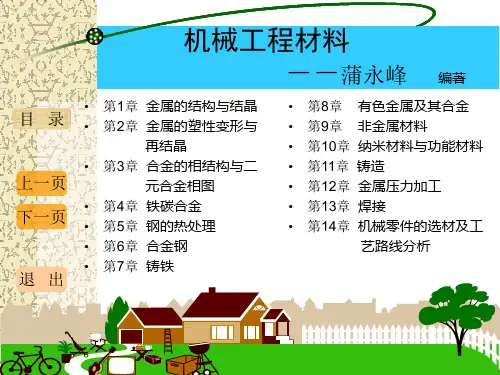

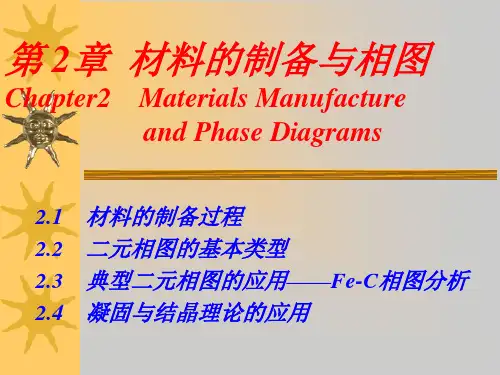


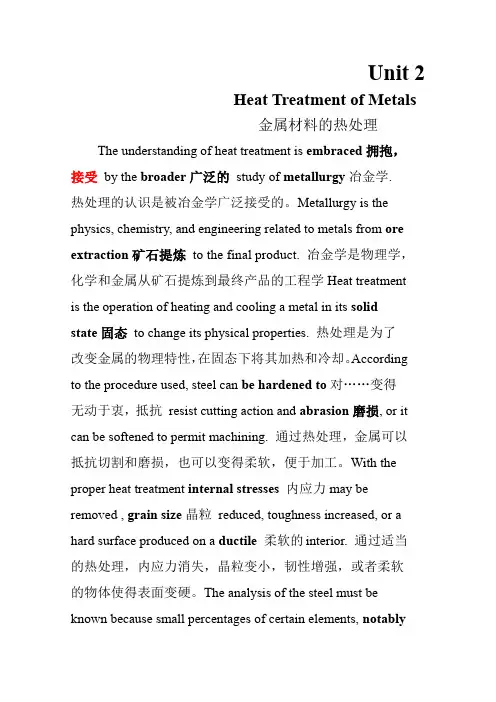
Unit 2Heat Treatment of Metals金属材料的热处理The understanding of heat treatment is embraced拥抱,接受by the broader广泛的study of metallurgy冶金学.热处理的认识是被冶金学广泛接受的。
Metallurgy is the physics, chemistry, and engineering related to metals from ore extraction矿石提炼to the final product. 冶金学是物理学,化学和金属从矿石提炼到最终产品的工程学Heat treatmentis the operation of heating and cooling a metal in its solidstate固态to change its physical properties. 热处理是为了改变金属的物理特性,在固态下将其加热和冷却。
Accordingto the procedure used, steel can be hardened to对……变得无动于衷,抵抗resist cutting action and abrasion磨损, or it can be softened to permit machining. 通过热处理,金属可以抵抗切割和磨损,也可以变得柔软,便于加工。
With the proper heat treatment internal stresses内应力may be removed , grain size晶粒reduced, toughness increased, or a hard surface produced on a ductile柔软的interior. 通过适当的热处理,内应力消失,晶粒变小,韧性增强,或者柔软的物体使得表面变硬。